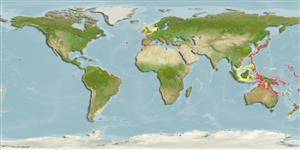Eudendrium glomeratum Picard, 1951
| Native range | All suitable habitat | Point map | Year 2050 |

|
| This map was computer-generated and has not yet been reviewed. |
| Eudendrium glomeratum AquaMaps Data sources: GBIF OBIS |
Upload your photos
Google image |
No photo available for this species.No drawings available for Eudendriidae.
Google image |
No photo available for this species.
Classification / Names Common names | Synonyms | CoL | ITIS | WoRMS
Hydrozoa | Anthoathecata | Eudendriidae
Environment: milieu / climate zone / depth range / distribution range Ecology
Demersal; depth range 5 - 40 m (Ref. 3086). Tropical
Distribution Countries | FAO areas | Ecosystems | Occurrences | Introductions
Atlantic Ocean, Western Pacific and the Mediterranean. Tropical to temperate.
Length at first maturity / Size / Weight / Age
Maturity: Lm ? range ? - ? cm
Short description Morphology
Complementary nematocysts macrobasic euryteles arranged in warts around hydranth body, usually absent from hypostome; male and female blastostyles completely reduced; spadix of female blastostyle unbranched when immature and shed when mature, encircled by perisarc and linked to axis of blastostyle by a short peduncle (Ref. 3086).
Life cycle and mating behavior Maturity | Reproduction | Spawning | Eggs | Fecundity | Larvae
Members of the order Anthoathecata are mostly colonial A-form hydroids. Life cycle: The zygote develops into planula inside the gonophore and is later released as an actinula which metamorphoses into polyp stage.
Main reference
References | Coordinator | Collaborators
Marques, A.C., A.L. Peña Cantero and W. Vervoort. 2000. (Ref. 3086)
IUCN Red List Status (Ref. 130435)
CITES status (Ref. 108899)
Not Evaluated
CMS (Ref. 116361)
Not Evaluated
Threat to humans
Human uses
| FishSource |
Tools
More information
Internet sources
BHL | BOLD Systems | CISTI | DiscoverLife | FAO(Publication : search) | Fishipedia | GenBank (genome, nucleotide) | GloBI | Gomexsi | Google Books | Google Scholar | Google | PubMed | Tree of Life | Wikipedia (Go, Search) | Zoological Record
Estimates based on models
Preferred temperature
(Ref. 115969): 17.2 - 28.9, mean 26.9 (based on 584 cells).
Price category
(Ref. 80766):
Unknown.


